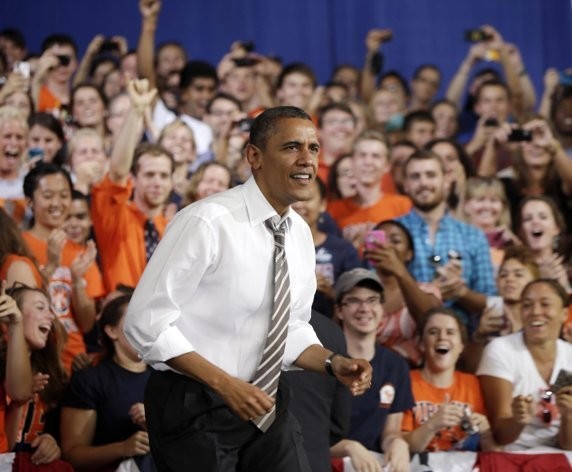More than 26,000 people combined showed up to hear the president speak during his three-state college town tour this week, which ended Wednesday with a rally near the University of Virginia. The crowds at the outdoor rallies have tilted younger, underscoring the Obama campaign's efforts to target college students as they return to school and re-energize a constituency that was critical in propelling Obama to the White House.
"Change was possible because you made it possible," Obama told 7,500 people at a pavilion near the University of Virginia. "So you can't get tired now because we've got more work to do."
The school declined the campaign's request for the president to speak on campus, saying it would disrupt classes on the second day of the semester.
By the standards of most presidential campaigns, Obama is speaking to impressively large audiences. But Obama is being held to the standards he set in 2008, when the youthful candidate with the rousing speeches attracted jaw-dropping crowds.
With thousands of young people crammed into the sweltering, standing-room-only open-air pavilion on Wednesday, hundreds more stood outside its fenced perimeter, in some places shoulder-to-shoulder 40 to 50 feet deep. But even some of those who went through heavy security to see Obama speak said their enthusiasm had waned.
"It no longer has the distinctiveness that it used to have," said William Proffitt, a University of Virginia student. "That was amazing, seeing the first African-American president elected, but that died off within a year."
In 2008, more than 100,000 people showed up to hear him speak in Denver. He spoke on the same trip at Colorado State University, where upwards of 50,000 people filled a quad in the center of campus. When Obama returned to Colorado State on Tuesday, the crowd totaled 13,000.
Obama's campaign dismisses the notion that the smaller crowds equal less enthusiasm for the president this time around. Aides suggest the numbers are purposely being kept low, citing the cost of holding larger events and the president's desire to travel to smaller cities in battleground states.
Security restrictions are also tighter around a current president than a candidate.
Obama drew his largest crowd in May, during his first re-election rally at Ohio State University. More than 14,000 people showed up to hear the president and first lady Michelle Obama speak, short of the 18,000 people the campaign predicted would fill the campus basketball arena to capacity.
Away from the college town circuit, the president has been generated even smaller audiences, often 3,000 people or less.
Campaign spokeswoman Jennifer Psaki said the president would still have "plenty of time for big rallies between now and Election Day."
The campaign is banking on big numbers next week when Obama accepts the Democratic nomination at an outdoor football stadium in Charlotte, N.C. The stadium holds up to 74,000 people.
Campaign aides won't say whether the full stadium will be open for seating during next Thursday's prime-time speech. Tens of thousands of tickets, called "community credentials", have been distributed, according to the campaign.
Obama also accepted his party's nomination in 2008 at an outdoor football stadium. His campaign had little trouble filling the 84,000 seats.
The president's aides say crowd size is one issue they're happy to debate with Republicans.
Even though Obama's audience numbers are down compared to his 2008 campaign, he is still drawing larger crowds than GOP rival Mitt Romney.
Most of Romney's events are carefully choreographed in made-for television settings that provide seating for hundreds of people, not thousands. An energy speech in Hobbs, N.M., last week, for example, drew only about 500 people.
Romney's campaign has been targeting larger venues since picking Wisconsin congressman Paul Ryan as his running mate. The duo drew an estimated 7,000 supporters to an outdoor rally in Michigan last week, one of the largest events for the GOP ticket this year.
-

President Barack Obama takes the stage to speak at a campaign event Wednesday at the University of Virginia in Charlottesville, Va. (AP Photo/Pablo Martinez Monsivais)
http://accesswdun.com/article/2012/8/252293
